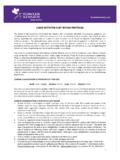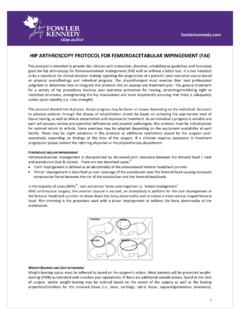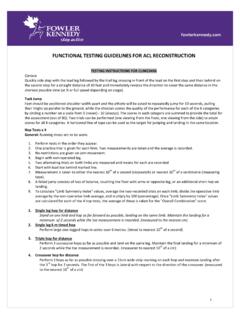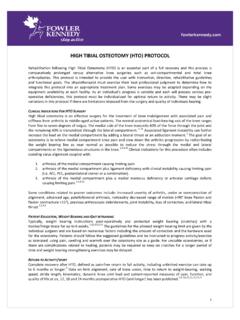Transcription of PHYSIOTHERAPY FOLLOWING ACL RECONSTRUCTION …
1 PHYSIOTHERAPY FOLLOWING ACL RECONSTRUCTION protocol . Rehabilitation FOLLOWING anterior cruciate ligament RECONSTRUCTION (ACLR) is an essential part of a full recovery. This protocol is intended to provide the user with instruction, direction, rehabilitative guidelines and functional goals. The physiotherapist must exercise their best professional judgment to determine how to integrate this protocol into an appropriate treatment plan. Some exercises may be adapted depending on the equipment availability at each facility. As an individual's progress is variable and each will possess various pre-operative deficiencies, this protocol must be individualized for optimal return to activity. There may be slight variations in this protocol if there are limitations imposed from additional associated injuries such as meniscal tears, articular cartilage trauma, bone bruising or other ligamentous injuries. This rehabilitation protocol spans over a 6 month period and is divided into 7 timelines.
2 Each timeline has goals and exercise suggestions for several domains: range of motion and flexibility, strength and endurance, proprioception, gait, and cardiovascular fitness. Criteria for progression within each timeline are based on the attainment of specific goals and on their Lower Extremity Functional Scale (LEFS) score. The focus in early rehabilitation is on regaining ROM, normalizing gait and activation of the quadriceps muscle. To ensure the best possible outcome for a safe return to the same level of activity prior to the injury, the client should be followed for the entire 6 months. The emphasis of rehabilitation should be focused at the 4-6 month mark. In these later stages, crucial skills such as plyometric training, agility drills, instructions on take-off and landing mechanics, patterning drills, and functional testing suggestions are given to determine the client's readiness for return to sport/activity. LOWER EXTREMITY FUNCTIONAL SCALE (LEFS).
3 The LEFS is a self report questionnaire used to evaluate the functional status of an individual with a lower extremity musculoskeletal dysfunction. It is easy to administer and easy to score in the clinical and research environment. The LEFS consists of 20 items, each scored on a 5-point scale (0 to 4). Item scores are summed and total LEFS scores vary from 0 to 80, with higher values representing better functional status. The LEFS is a reliable and valid tool for assessing change in functional status. True clinically important change has occurred if the score (51). changes 9 or more scale points from a previous score . In each corresponding timeline of the protocol the ranges of the LEFS scores are presented. These scores were derived from data on 55 ACLR patients between the ages of 18-65 years of age from our facility. The LEFS scores provided should not be used in isolation as they are intended to be an adjunct to the protocol , the functional testing guidelines and to sound clinical reasoning.
4 PRE-OPERATIVE REHABILITATION. (39). Rehabilitation should commence prior to surgery. After an ACL injury, deficits occur in strength , (40,56) (55) (13). proprioception , muscle timing and gait patterns . In fact, strength and proprioceptive alterations occur in (10,21,52,55). both the injured and uninjured limb . The primary impairment with an ACL deficient knee is instability. This is manifested by episodes of giving way', which can lead to further joint damage and ultimately, long term (19). degenerative changes . Research has demonstrated that PHYSIOTHERAPY provided pre-operatively is effective in increasing strength and balance which may limit the number the episodes of giving way' and decrease the (18,26). incidence of re-injury in the ACL deficient knee . The main goals of a pre-habilitative' program prior to surgery include: full range of motion equal to the opposite knee, minimal joint swelling, adequate strength and (45). neuromuscular control, and a positive state of mind.
5 All of these factors facilitate optimal post-operative recovery. It is important to maintain the highest level of strength and function possible in the unaffected leg as it will be used for comparison to assess the progress of the reconstructed knee, in the later stages of (22,23). rehabilitation . (1,47,48). RANGE OF MOTION & FLEXIBILITY. After ACLR it is important to restore and maintain full range of motion (ROM) in the knee. Quadriceps re-training (44). has been found to improve ROM in the early stages . Attaining full knee extension as early as possible is not 1. (43). deleterious to the graft or to joint stability and may prevent patellofemoral pain and compensatory gait pathologies. A stretching program is incorporated to maintain lower extremity flexibility. Research recommends that a 30 second stretch is sufficient to increase ROM in most healthy people. It is likely that longer periods of time, or more repetitions, are required for those individuals with injuries or with larger muscles.
6 Body mass has been shown to be positively correlated with muscle stiffness ( , the bigger the muscle, the more (34). stiffness/tension there exists) . Therefore, for larger muscle groups in the lower extremity, it is suggested to increase in the number of repetitions (ie. 3-5 times) for optimal flexibility. GAIT RETRAINING. Altered gait kinematics from quadriceps dysfunction is typical during the first stages post ACL RECONSTRUCTION . Typical adaptations include reduced cadence, stride length, altered swing and stance phase knee ROM, and (11,13,15,30). decreased knee extensor torque with hip and/or ankle extensor adaptations . Early weight bearing is advocated post ACLR in an attempt to restore gait kinematics in a timely fashion, facilitate vastus medialis function (53). and decrease the incidence of anterior knee pain . Treadmill training in the middle stages of rehabilitation can further assist in normalizing lower extremity ROM. across all joints, especially with incline or backwards walking.
7 Backwards treadmill walking has been shown in the literature to increase ROM and increase functional quadriceps strength, while minimizing patellofemoral stress. It (49). is also beneficial for specific return-to-sport preparation requiring a re-training of backwards locomotion . MUSCULAR STRENGTH & ENDURANCE TRAINING. Muscle analyses of the quadriceps post ACL injury have shown: i) similar degrees of atrophy in both type I. (oxidative/endurance) and II (glycolytic/fast-twitch) muscle fibres, and ii) physiological metabolic shifts in muscle (35,50). fibres from gylcolytic into oxidative compositions . This means that ACL rehabilitation must include variable training parameters, which range from an endurance program of low load/high repetitions to a strength oriented phase of high load/low repetitions to focus on these deficits. Depending on the graft type used for ACLR (patellar tendon vs. semitendonosis/gracilis), specific strength deficits have been found. With the patellar tendon graft, there are low velocity concentric extensor deficits specific to 60- (23).
8 95 ; with the hamstring graft, there are high velocity, eccentric flexor deficits specific to 60-95 . Strengthening exercises need to be velocity, ROM and contraction specific to address these deficits. Open (OKC) and Closed (CKC) Kinetic Chain Exercises OKC exercises have previously been contraindicated in ACLR patients for 6 months up to a year post-operatively, although the concern about the safety of OKC training in the early period after ACLR may not be well founded. It was originally thought that OKC exercises increased anterior tibial translation, with the possibility of increasing strain on the new graft. However, research has demonstrated that there are minimal strain differences between (4,5). OKC leg extension and CKC activities such as squatting . With the addition of OKC training, subjects have shown (25,37). increased quadriceps torque increases without significant increases in laxity . Researchers are now advocating the addition OKC exercises, at the appropriate time and within a restricted range, to complement the classic CKC.
9 (25,37,38). rehabilitative program . Quality vs. Compensation Physiotherapists often feel compelled to progress patients by giving them new exercises each time they are in for therapy. It cannot be stressed enough that it is not beneficial to give patients exercises they are not neuromuscularly ready for. It is very important to observe the quality of the exercises that are being performed, specifically with CKC exercises. Weaknesses in specific muscle groups lead to compensations, which produce faulty movement patterns. These faulty patterns are then integrated into unconscious motor programs, which perpetuate the original weakness. Specifically, the research has indicated that knee extensor moment deficits are (11,15). compensated for by hip and/or ankle extensor moments . If these are allowed to occur and are not corrected, any joint or structure along the kinetic chain may be exposed to injury. 2. (16). For example: A squat or lunge must be performed with the trunk perpendicular to the ground (to avoid excessive hip flexion), the iliac crests must be level (to avoid Trendelenburg/hip hiking), and the knee must be over the foot with the tibia perpendicular to the floor (to avoid excessive dorsiflexion).
10 It is better to decrease the range of movement (half squat vs. full squat) than to do the exercise at a level that is too difficult to perform correctly without compensation. Precautions with Hamstring Grafts The typical donor graft for ACLR at this facility is the hamstring (semitendinosis / gracilis). Careful measures must be taken to avoid overstressing the donor area while it heals. Although, isolated hamstring strengthening is initiated around the six-week mark in this group, it is important for the therapist to be aware of the natural stages of healing. There may be too much stress too early if the patient reports pain at the donor site during or after specific exercises. NEUROMUSCULAR & PROPRIOCEPTIVE RETRAINING. Ideally proprioception should be initiated immediately after injury (prior to surgery), as it is known that (10,55). proprioceptive input and neuromuscular control are altered after ACL injury . By challenging the proprioceptive system though specific exercises, other knee joint mechanoreceptors are activated that produce compensatory (9).




